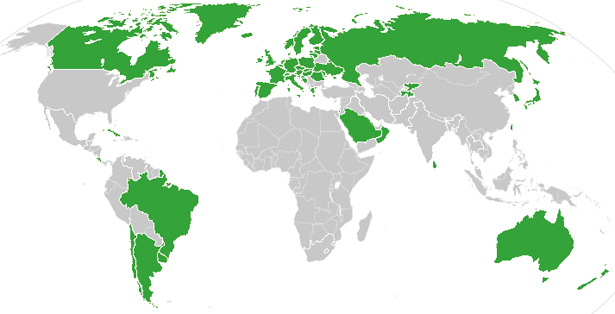Here's a Map of the Countries That Provide Universal Health Care (America's Still Not on It)
The U.S. stands almost entirely alone among developed nations that lack universal health care.
As excited as American liberals and proponents of expanding access to health care might be about the Supreme Court's decision to largely uphold the Affordable Care Act, the U.S. still stands out from much of the developed world in state efforts to make medical care available to the public. If universal health care in the U.S. is your goal, then today was a big step forward, but maybe also a reminder of how far behind America still lags.
The above map shows, in green, countries that administer some sort of universal health care plan. Most are through compulsory but government-subsidized public insurance plans, such as the UK's National Health Service. Some countries that have socialized and ostensibly universal health care systems but do not actually apply them universally, for example in poverty- and corruption-rife states in Africa or Latin America, are not counted.
What's astonishing is how cleanly the green and grey separate the developed nations from the developing, almost categorically. Nearly the entire developed world is colored, from Europe to the Asian powerhouses to South America's southern cone to the Anglophone states of Australia, New Zealand, and Canada. The only developed outliers are a few still-troubled Balkan states, the Soviet-style autocracy of Belarus, and the U.S. of A., the richest nation in the world.
The handful of developing countries that provide universal access to health care include oil-rich Saudi Arabia and Oman, Latin success story Costa Rica, Kyrgyzstan, and, famously, Cuba, among a few others. A number of countries have attempted universal health care but failed, such as South Africa, which maintains a notoriously inefficient and troubled public plan to complement the private plans popular among middle- and upper-class citizens.
None of this is to downplay the importance of today's Supreme Court ruling for supporters of the U.S. effort to expand health care coverage, nor to argue that U.S. health care is equivalent to that in, say, Egypt or Belarus. It's precisely because the quality of U.S. health care is so high that makes this map interesting.
That brings us to another way that America is a big outlier on health care. The grey countries on this map tend to spend significantly less per capita on health care than do the green countries -- except for the U.S., where the government spends way more on health care per person than do most countries with free, universal health care. This is also true of health care costs as a share of national GDP -- in other words, how much of a country's money goes into health care.
"The overall level of health spending in the United States is so high that public (i.e. government) spending on health per capita is still greater than in all other OECD [Organization for Economic Cooperation and Development] countries, except Norway and the Netherlands," according to a recent OECD report, which covers most of the developed world.
Whether or not that will change with President Obama's health care reform now Supreme Court-approved, access to health care will remain yet another way in which the U.S. stands out from the rest of the developed world.
